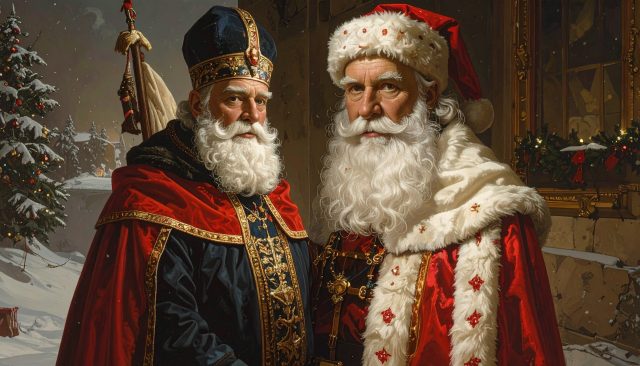The modern image of Santa Claus did not appear overnight. It took more than a thousand years of legends, cultural exchanges, regional traditions, and creative reinventions to shape the red suited figure children recognize today. What began as the story of a generous Christian bishop in ancient Myra slowly blended with Norse myths, Dutch customs, British storytelling, and American pop culture.
Across centuries Santa absorbed traits from separate traditions. Sailors carried his stories across ports, immigrants brought their customs to new continents, magazines and advertising campaigns amplified his appearance, and writers reinvented his personality for new generations. The result is a global icon who feels timeless even though the version we know today is surprisingly recent.
This list breaks down the most important turning points in the evolution of the Santa figure. These are the shifts, legends, and creative decisions that transformed a fourth century saint into a worldwide symbol of generosity and holiday magic.
10. The Real Saint Nicholas Inspires the Origin Story
The earliest and most authentic origin of Santa Claus comes from a single historical figure: Saint Nicholas of Myra. He was a Christian bishop who lived in the 4th century (270–343 AD) in what is now modern-day Turkey. Nicholas was revered throughout the Mediterranean for his extraordinary piety and numerous acts of charity.
His kindness laid the foundation for every later version of the gift-giver. The most famous story involves him secretly tossing bags of gold coins into the window of a poor man’s home to save his three daughters.
These widely shared tales of secret gift-giving, protecting the innocent, and saving children quickly established his legacy as the prototype for the Christmas gift-giver and a powerful patron saint. This historical figure is the essential starting point for the 1,000-year evolution of the man in the red suit.
9. Medieval Europe Turns Nicholas into a Miracle Worker
During the Middle Ages, the legend of Saint Nicholas grew exponentially, cementing his place in European folklore and setting the stage for the modern Santa Claus. As devotion to saints flourished, churches dedicated to Nicholas appeared across the continent, particularly in Italy, Russia, and northern Europe.
Storytellers enhanced his biography by adding elaborate miracles to his life. These tales moved him beyond simple charity, transforming him into a powerful, symbolic guardian who intervened directly in the lives of the faithful.
- Protector of Children: The most famous medieval legend involved Nicholas resurrecting three children who had been murdered by an innkeeper and hidden in a brine barrel. This dark, popular tale solidified his role as the ultimate protector of children.
- Patron of Travelers: Due to his ties to the port city of Myra, he was already associated with sailors. The new miracles established him as a patron of merchants, fishermen, and travelers, ensuring his story was carried far and wide across new continents.
These widespread tales elevated Nicholas from a charitable bishop to a supernatural figure who could reward good behavior and punish vice, preparing the figure for his eventual role as a symbol of seasonal judgment.
8. Dutch Settlers Bring Sinterklaas to the Americas
The most direct ancestor of the modern Santa Claus arrived in North America when Dutch settlers established the colony of New Amsterdam (which would later become New York). In the Netherlands, the legend of Saint Nicholas had evolved into Sinterklaas, a figure whose traditions were already deeply rooted.
Unlike the simple bishop of Medieval times, Sinterklaas was a grand, recognizable figure.
- He wore the red robes and tall mitre of a bishop and carried a shepherd’s crook.
- He did not fly in a sleigh; he rode a white horse across the rooftops.
- He carried a book that recorded whether children had been naughty or nice.
When Dutch immigrants brought the annual celebration of Sinterklaasavond (St. Nicholas Eve) to the colonies, the name and basic custom of a mysterious gift-giver were firmly planted in the New World. This tradition would eventually blend with other European customs to become the uniquely American Santa Claus.
7. Washington Irving Americanizes Sinterklaas
The next major step in the history of Santa Claus came through the pen of American writer Washington Irving. In his satirical 1809 book, A History of New York by Diedrich Knickerbocker, Irving took the Dutch tradition of Sinterklaas and reimagined it for a new American audience.
Irving’s writing transformed the figure. He described Sinterklaas not as the solemn bishop of old, but as a jolly gift bringer who wore a broad-brimmed hat and flew over the rooftops in a wagon.
This was a crucial moment in the evolution of Santa. Irving secularized the figure, effectively detaching him from religious ceremony and rooting him firmly in American storytelling and folklore. By blending the Dutch customs with his own creative, lighthearted narrative, Irving established the prototype for the modern Santa Claus known for his cheer and ability to fly.
6. The Poem “A Visit from Saint Nicholas” Creates Key Features
The publication of the famous poem “A Visit from Saint Nicholas” in 1823, often known as The Night Before Christmas, was arguably the most crucial event in shaping the modern Santa Claus. This single piece of American literature is responsible for introducing almost all the fantastical elements children recognize today:
- The Look: Santa was depicted as a “jolly old elf” with twinkling eyes, rosy cheeks, and a beard “as white as the snow.” He was stout, giving him his familiar plump figure.
- The Transportation: The poem gave Santa his magical sleigh and his team of eight flying reindeer (Dasher, Dancer, Prancer, Vixen, Comet, Cupid, Donner, and Blitzen).
- The Entrance: The poem firmly established the tradition of entering homes through the chimney.
While the poem is usually credited to Clement Clarke Moore, the poem’s authorship remains one of American literature’s great debates. Regardless of the author, the poem instantly cemented the joyful, whimsical tone of modern Santa and solidified his identity as a mystical, benevolent figure for generations to come.
5. Santa Becomes a Fixture of American Holiday Culture
The 19th century saw Santa Claus rapidly transition from a figure in poetry to a national icon. This mass adoption was enthusiastically driven by the era’s burgeoning media: newspapers, artists, and department stores.
The most significant artistic influence came from illustrator Thomas Nast, whose detailed drawings for Harper’s Weekly between 1863 and the 1880s cemented Santa’s rosy-cheeked appearance, his fur-trimmed suit, and the idea of his workshop being located at the North Pole.
Department stores were quick to realize his commercial potential, rapidly installing “Santa’s Grottoes” and featuring the jolly figure prominently in their advertising to sell products. This enthusiastic commercial embrace ensured that by the end of the 19th century, Santa Claus was firmly woven into the fabric of American holiday culture, becoming the undisputed mascot of the growing national Christmas market.
4. Thomas Nast Creates the First Recognizable Santa Image
Political cartoonist Thomas Nast is the man most responsible for the definitive modern Santa Claus image. While the 1823 poem provided the lore (reindeer and a sleigh), Nast provided the visuals. Working primarily for Harper’s Weekly starting in 1863, Nast transformed the earlier, vague descriptions into a single, cohesive visual icon.
He is credited with cementing many essential traits:
- The red suit trimmed with white fur, replacing earlier variations that were often brown, green, or blue.
- The round belly, jovial expression, and twinkling eyes.
- His permanent residence and central operations at the North Pole.
- The idea of a workshop where toys were made and a ledger for keeping track of the naughty and nice lists.
Nast’s hugely influential drawings became the visual standard for generations, overriding all previous regional figures and creating the universally accepted Santa figure we recognize today.
3. Corporate Art Standardizes the Red Suit (The Coca-Cola Effect)
By the early twentieth century, companies began using Santa in advertisements, recognizing his immense commercial appeal. While Santa’s basic look was established by Thomas Nast, his precise, consistent image was cemented by corporate art.
The most famous and influential standardization came in the 1930s, when The Coca-Cola Company commissioned artist Haddon Sundblom to create annual holiday advertisements. Sundblom’s paintings depicted Santa as a jolly, human-sized man, complete with twinkling eyes and a full white beard.
This powerful and widely distributed advertising campaign effectively cemented the key visual elements: the specific shade of Coca-Cola Red for his suit and the cheerful, universally welcoming personality. This transition took Santa from a figure of American folklore to a universal global marketing icon in a way no previous step had achieved.
2. Hollywood and Radio Launch Santa as a Global Icon
By the mid-twentieth century, the final step in Santa’s evolution was taking the American version global. Mass media, including radio, Hollywood films, and early television programs, provided the perfect tools for universal adoption.
Radio was instrumental in standardizing the sensory details: it cemented the iconic “ho ho ho” laugh, the sound of the sleigh bells, and the magical atmosphere of the North Pole for listeners around the world. Meanwhile, films cemented his personality and visual consistency. Iconic movies like Miracle on 34th Street (1947) added psychological depth, ensuring Santa was understood as a benevolent figure of faith, not just a jolly man.
This powerful, consistent messaging across continents transformed Santa from a North American Christmas figure into a truly worldwide symbol of the holiday. He became instantly recognizable by billions, ensuring his enduring status as the definitive modern gift-giver.
1. Santa Becomes a Universal Icon of Global Kindness
By the twenty first century, the evolution of the Santa Claus figure reached its final, most widely adopted form. Having shed his heavy religious and regional ties, he transitioned into a truly international symbol recognized by billions worldwide, often transcending specific Christian traditions.
His universal appeal lies in his core message. He is now the global icon of generosity, hope, and kindness. This secular, positive identity allowed diverse nations and cultures to combine his imagery with their own unique holiday customs.
Santa’s story continues to evolve in modern times, being constantly reinterpreted in film, art, and advertising worldwide. His enduring presence is a testament to the powerful, universal desire to celebrate the magic of giving and the enduring spirit of the holidays.
Conclusion: The Global Icon of Giving
The Santa Claus known today is the result of centuries of storytelling and unparalleled cultural blending. What began as the tale of a compassionate bishop transformed gradually through folklore, immigration, poetry, art, and mass entertainment. Each era added a new layer, with the figure absorbing traits from Dutch customs and American pop culture.
The culmination of this long journey is a true global icon, who represents universal themes of kindness and imagination. His evolution is a fascinating case study in how legends grow across generations and how a simple story of giving can unite people around the world, proving that sometimes, the most enduring tradition is one of constant change.


